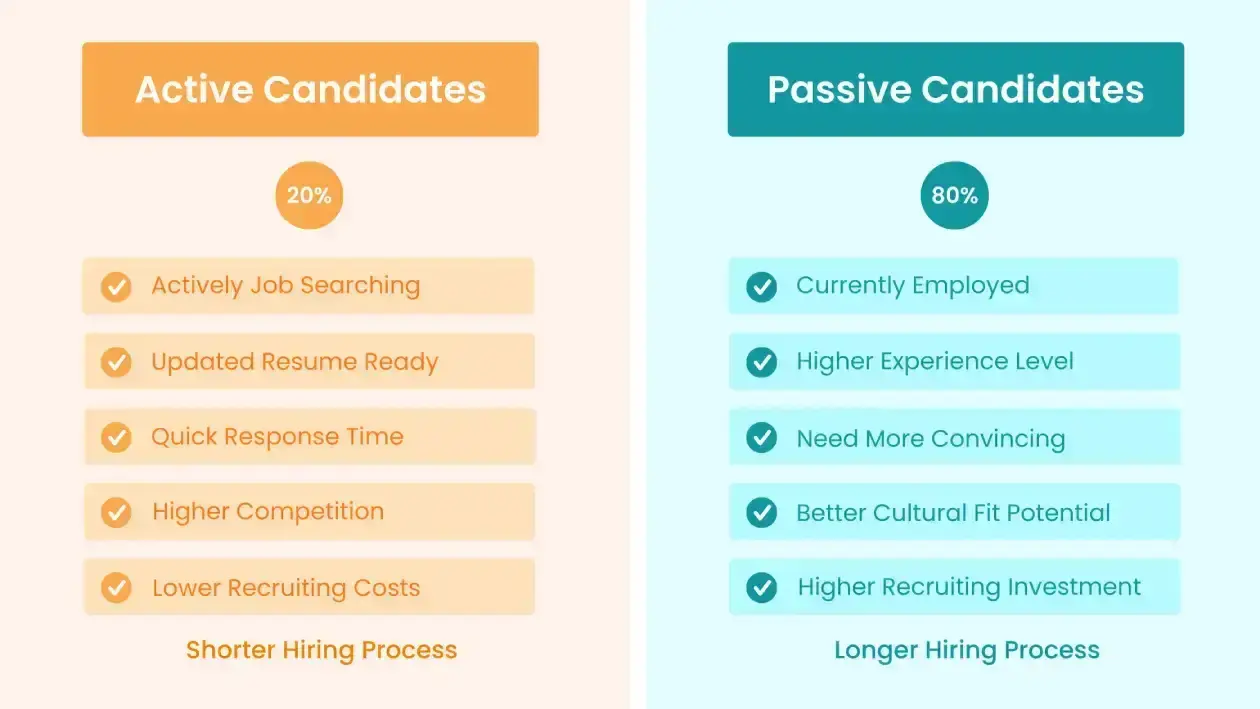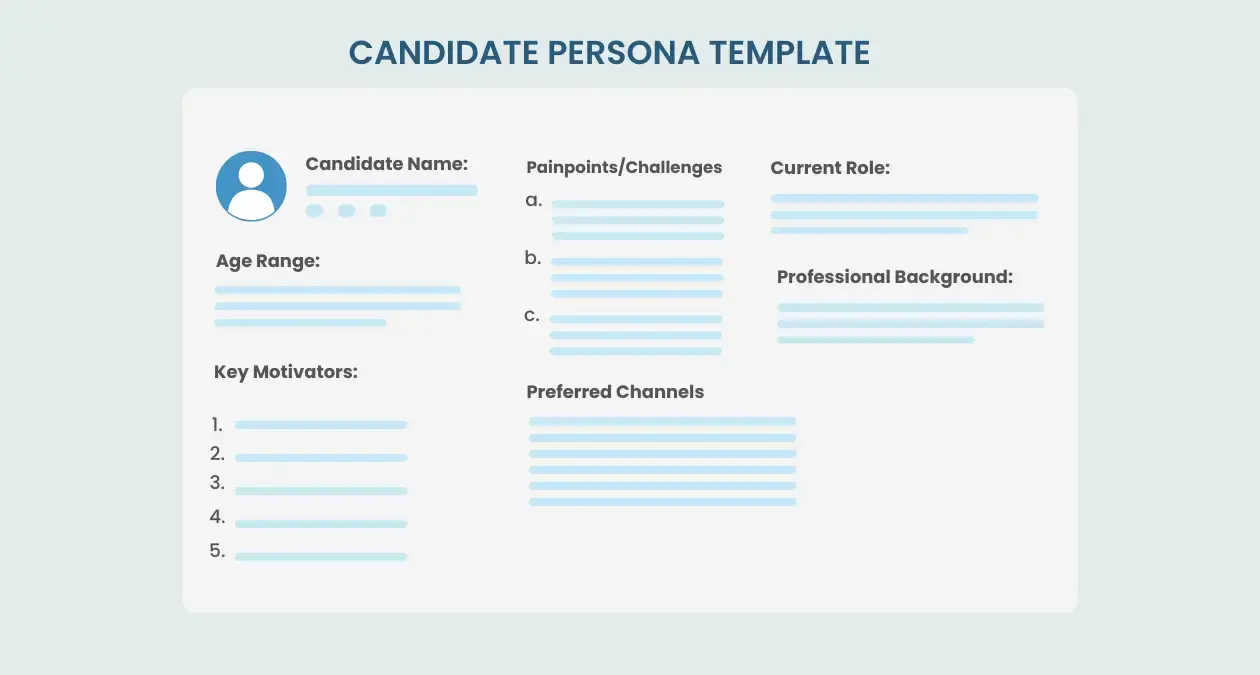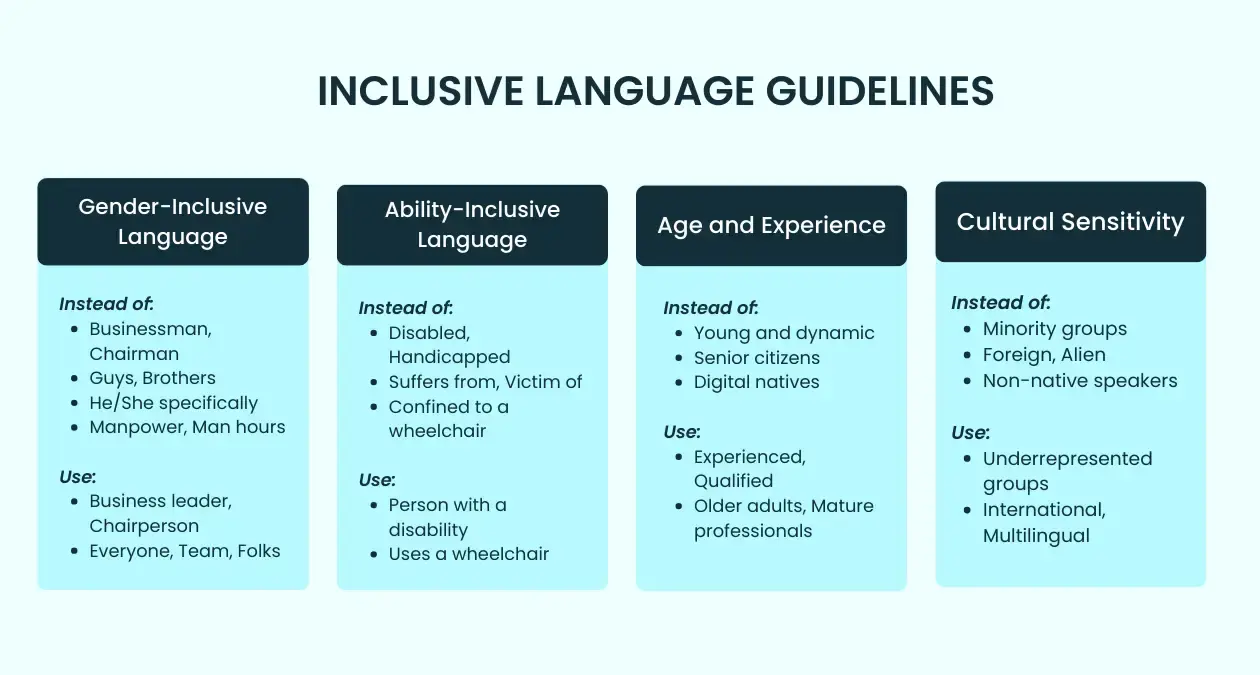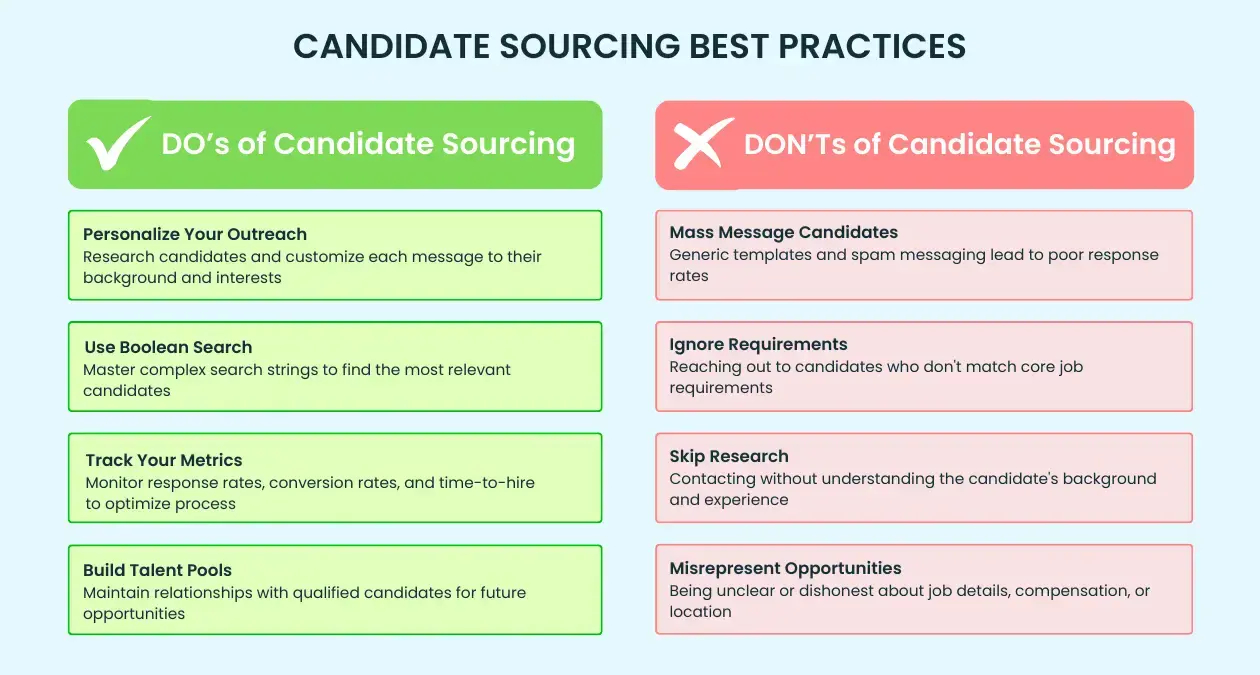TL;DR
- Candidate sourcing is proactive in finding potential employees before they apply, improving hire quality and diversity.
- A step-by-step sourcing process includes understanding vacancies, researching roles, searching talent, contacting candidates, pre-screening, and collaborating with hiring managers.
- Executive-level sourcing involves networking, referrals, specialised job sites, and internal mobility.
- Innovative strategies leverage AI, data, community building, and sustainable practices for better talent acquisition.
- Tracking key sourcing metrics helps refine strategies to improve efficiency and candidate quality.
- Using the right tools like iSmartRecruit and others streamlines the sourcing process and engages passive candidates.
- Diversity and inclusion in sourcing promote fair hiring, broaden candidate pools, and reduce bias through strategic methods and technology.
Are you having trouble finding the right people for your job openings? Do you feel like you spend more time looking for candidates than talking to them? You're not the only one.
In today's competitive job market, crafting an effective candidate sourcing strategy is crucial. With fewer people available and more jobs, finding the perfect person for your open positions has become harder.
Don't worry; you'll learn about candidate sourcing in this article. Here, you'll get the gist of knowledge to boost your sourcing efforts and practical tips. This will help you make your candidate search strategy better.
You'll find answers to questions like:
-
What are the best ways to source passive candidates?
-
How do you set a budget for finding candidates?
-
How to source executive-level candidates?
And much more!
Let's get started!
What is Candidate Sourcing, and Why is it Important?
Candidate sourcing is about actively looking for potential employees before they even apply for a job. This is different from the usual way of hiring, where you wait for people to apply.
Key points include:
-
Reaching out to people who aren't actively looking for a job but might be interested in the right opportunity.
-
Expanding your search to include a wider and more diverse group of people can lead to better hires.
-
Focus on finding people with the exact skills, experience, and personality that fit your company.

In my experience, candidate sourcing significantly enhances the quality of hires by focusing on candidates who are often well-settled and capable of making a long-term impact.
Sourcing vs Recruiting: What’s the Difference?
|
Aspect |
Sourcing |
Recruiting |
| Definition | Proactively searching for potential candidates. | Engaging, interviewing, and selecting candidates. |
| Objective | Build a talent pool of qualified candidates. | Convert candidates from the pool into hires. |
| Key Activities | Searching and identifying talent & Engaging passive candidates. | Screening and interviewing & Making job offers. |
| Outcome | A pool of potential candidates. | A final hire who fits the role. |
How to Source Candidates?
Finding the right candidates involves more than just posting a job and waiting for people to apply - it means actively looking for the best talent. Here’s a simple, step-by-step guide to the candidate sourcing process:
1. Find Out About Upcoming Vacancies: Work with department leaders to understand future hiring needs and make sure your sourcing efforts match the company’s goals. Use tools like ATS to analyse past hiring patterns and skill gaps and keep an eye on industry changes to predict new roles. Create a clear profile of the ideal candidate, including their skills, experience, and qualities, to focus your search.

2. Research Open Role Requirements: Talk to hiring managers to get a clear picture of the job’s main duties, necessary skills, and the kind of person who fits the company culture. Go beyond the job description by considering potential challenges and creating a detailed "Role Brief Document" to keep your sourcing consistent.
3. Search for Talent: Use websites like LinkedIn, Indeed, and specialised sites (like GitHub) to look for candidates. Use specific boolean search terms to narrow down results, get help from referrals and talent groups, and reach out to people who aren't actively looking for a job to find hidden potential.
4. Contact Candidates: Customize your messages to show the benefits of the job and match them with the candidates' interests. Keep a professional but friendly tone to encourage interaction and create a good candidate experience.
5. Pre-screening Phase: Have quick phone calls to check qualifications, see if they fit the company culture, and determine their interest. Use a consistent list of questions to make fair evaluations and focus on technical skills and personal qualities.
6. Send Shortlisted Candidates to Managers: Create brief reports that summarise the candidates' skills, experience, and how well they fit the role. Support your choices with information from the initial screening and assessments, and work with the hiring managers to agree on what they're looking for.
Statistics: Collaboration between recruiters and hiring managers enhances hire quality by 25%, reducing time-to-hire with better efficiency.
Source: Standout-CV
This streamlined approach ensures an effective candidate sourcing process and helps identify the best talent for every role.
How to Source Executive-Level Candidates?
Finding the right people for top executive positions needs a smart plan to reach both well-known and hidden talent. Here are the main ways to do it:
1. Use Networking: Connect with important professionals through industry groups, events, and professional networks.
2. Get Referrals: Ask your current leaders for recommendations of potential candidates. Referrals often bring in great hires.
3. Use Special Job Sites: Post on job boards and forums that focus on executive roles to attract high-level candidates.
4. Consider internal mobility: Promote or move current employees who know your company well into higher roles. This saves time and lowers the risk of hiring mistakes.
Using these methods and ensuring they fit your goals, you can bring in top executives who will help your company succeed.
Innovative Candidate Sourcing Strategies
Finding the right people for your team has become harder than before, and old ways of doing it often don't work well. To succeed, it's important to use new and creative ways to source candidates and ensure they are a good fit. These methods use modern tools, data, and clever ideas to meet today's hiring needs.
Here are some advanced strategies that can improve your search for candidates. Each one is made to solve particular problems and help you find a diverse group of qualified people.
List of Candidate Search Strategies
-
Traditional Methods (Enhanced)
-
AI-Powered Sourcing
-
Digital Platforms
-
Emerging Technologies
-
Alternative Talent Pools
-
Candidate Experience
-
Data-Driven Approaches
-
Community Building
-
Sustainable Practices
Start using these strategies to make your candidate search more effective and ready for the future!
Candidate Sourcing Metrics to Track
Tracking candidate sourcing metrics is not just about gathering numbers; it's about understanding how well your efforts match your hiring goals. These metrics show which sourcing strategies are working, where resources should be focused, and what changes you can make to improve both efficiency and the quality of candidates.
By paying attention to measurable results, you can adjust your sourcing methods, ensure a steady increase in candidate leads, and make decisions based on data that improve the quality and diversity of your hires.
Here are the key sourcing metrics every recruiter should track:
-
Rehire/Referral Rates
-
Candidate Pipeline Growth
-
Sourcing Channel Efficiency
-
Passive vs. Active Candidates
-
Response Rate
-
Time-to-Source
-
Employee Referral Rates from Sourced Hires
-
Candidates per Sourcing Channel
-
Cost per Sourcing Channel
-
Sourcing Channel Effectiveness
-
Quality of Hire (QoH)
-
Diversity Metrics
-
Candidate Pipeline Health
By focusing on these metrics, you'll get a good idea of how well your sourcing strategy is working and be able to make quick changes to reach your hiring targets. The aim is not just to collect data but to use this information to make practical improvements.
What are the Tools and Platforms for Effective Candidate Sourcing?
The right tools and platforms are very important when finding the best people for a job. The right mix of technology can help you find the perfect candidates. Here are some of the best tools that have been shown to work well for finding candidates:
-
iSmartRecruit
-
SeekOut
-
Gem
-
HireEZ
-
LinkedIn and LinkedIn Recruiter
-
Manatal
-
GoHire
-
Workable
-
Loxo
-
Indeed
Each tool has special features to help with different challenges in finding candidates, so there isn't a single tool that works for everyone. The important thing is to find the right combination of tools that fit your hiring needs. These tools are meant to make your work easier - use them well to improve your strategy for finding candidates!
How to Include Diversity and Inclusion in Finding Candidates?
Including diversity and inclusion (D&I) in hiring means actively looking for people from groups not often represented and avoiding unfair judgments to make a fair hiring process. To get a wider range of candidates, use different networks and platforms, and make sure job descriptions use language that focuses on skills and is welcoming to many people.
Use methods like hiding names on resumes and structured interviews to base decisions on qualifications, not guesses. D&I is not just about race or gender; it also includes age, disability, and different ways of thinking. You can find great talent from various backgrounds by promoting inclusion and reducing bias.

Strategies to Incorporate D&I in Sourcing:
-
Strategic Foundation
-
Sourcing Channel Diversification
-
Job Description and Communication
-
Search Process Optimization
-
Technology and Tools
-
Team Development
-
Pipeline Development
-
Engagement Strategies
-
Measurement and Analytics
-
Continuous Improvement
-
Partnerships and External Relations
These strategies ensure your sourcing process is inclusive and attracts a diverse talent pool.
Common Candidate Sourcing Mistakes and How to Avoid Them
Even experienced recruiters can make mistakes that hurt their success in finding candidates. Here are some common errors and how to avoid them:
1. Over-reliance on One Channel
Use different ways to find candidates, like social media, referrals, special websites, and events, instead of just job boards or LinkedIn.

2. Neglecting Passive Candidates
Keep in touch with people who aren't actively looking for jobs by sending them updates so they think of your opportunities for future roles.
3. Ignoring Data Insights
Use tools like ATS to track how many people respond and the quality of candidates to improve your strategy.
Avoiding these mistakes helps you reach more people and find better candidates, making the hiring process easier.

Why Choose iSmartRecruit to Source the Best Talent?
When finding the best talent, iSmartRecruit makes a big difference. Here's why:
iSmartRecruit provides a complete solution that makes the hiring process easier and better. With iSmartRecruit, you can use advanced tools like AI to match candidates, search for the right people, and send messages automatically - helping you find the perfect talent quickly.
One of the best features is the AI-powered candidate search, which helps you quickly go through many applicants and find the ones who are the best match for your job openings. This saves time and improves the quality of your hires by considering skills, experience, and even how well they fit with your company culture.
Also, iSmartRecruit's Candidate Relationship Management (CRM) lets you easily manage a group of potential hires. You can connect with passive candidates, keep track of your interactions, and help them become better fits for your company.
In summary, iSmartRecruit gives you the tools to effectively find and manage top talent.
Final Wrap-Up for Candidate Sourcing
Wrapping up, Wrapping up, the journey of candidate sourcing is an ever-evolving adventure. To summarise, finding candidates is always changing and full of surprises. You've learned about different ways and tools to find candidates - using social media, reaching out to people who aren't actively looking for a job, and using new technology. Remember, the aim is not just to fill positions but to discover those special people who will improve your team.
Stay personal, creative, and determined in your approach. Every step to build connections will help you find more great people. In the end, successful candidate sourcing is not just about finding any candidates; it's about finding the perfect ones.
So, keep learning and never stop looking. Your next amazing hire is waiting out there.
FAQs - Frequently Asked Questions
What is the main benefit of using iSmartRecruit for candidate sourcing?
iSmartRecruit simplifies your hiring by using AI to find the best candidates quickly. It also offers tools to manage talent pools and connect easily with passive candidates, helping you make better hires faster.
How can I attract passive candidates?
Reach out with personalised messages highlighting benefits that match their interests. Maintain a friendly tone and keep communication ongoing to stay on their radar for future opportunities.
Why is diversity important in candidate sourcing?
Diversity brings varied perspectives and skills, which can improve your team's performance. Inclusive hiring ensures fairness and helps you find unique talent from different backgrounds.
What are common mistakes to avoid in sourcing candidates?
Don't rely on just one channel, ignore passive candidates, or overlook data insights. Using varied methods and data helps reach more candidates and improves the quality of hires.



















